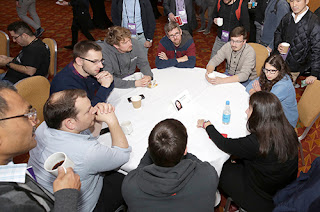A healthy relationship between Product Management and Engineering is critical to build successful products. It’s also essential in creating a team where people want to work.
When it goes well, we’re two partners working shoulder to shoulder towards a shared mission. Each is grateful for the contribution of the other. When it goes badly, there’s finger pointing, ignored input, wasted work, frustrating processes, and resentment.
Here are the 4 keys to a healthy engineering and product management relationship.
Share Leadership and Credit
One of the top ways Product Managers damage relationships with engineers is by hoarding all the credit. They claim that they thought of all the ideas and make sure they’re always the ones presenting to executives, leading meetings, or announcing results. They act like they’re the most important person on the team.
Explicitly share leadership between product managers, engineers, and designers. Each role has a clear responsibility, but we all work together to share our points of view and come to better solutions together. We have different points of view, but we all know we’re on the same team working towards shared goals.
One specific way to share leadership responsibilities is through the concept of Program Lead (PL), who can be either a Product Manager or an Engineer on the team. PLs own communicating progress, establishing the rhythm for the team, and team unity. The Program Lead can be the same person as the Tech Lead, but on some teams, they are different engineers — one person is responsible for running the team, while the other person is responsible for the technical direction.
Another way to share leadership and credit is with Key Results. These are team goals that get shared across the company. We assign them to the person who contributes the most towards their success, whether it’s an engineer, PM, designer, user researcher, or data scientist.
With this system, more people get to take on leadership roles and everyone gets recognition for their work.
Include Engineers in Product Decisions
Some PMs think it’s their job to have all the ideas and do all the product thinking. They’ll go off with their designers and come up with a grand vision to toss over the wall to the engineers for implementation. If an engineer comes up with a proposal, they’ll quickly dismiss it — either out of a lack of respect or being territorial.
Engineers need to be involved and can lead product direction from the beginning of the product lifecycle. Gather input from across the company when planning a roadmap and include all the engineers on a team in research and design brainstorming at the beginning of each project.
Engineers appreciate understanding the reasoning behind product decisions. PM’s love when engineers come up with valuable ideas enabled by creative technical solutions. We know that aligning everyone on the team around a shared purpose and shared understanding will help achieve bigger and better things together.
Clarify Roles and Reinforce them with Mutual Respect
An easy way to muddle any work relationship is with unclear roles and lack of respect. PMs insult engineers by trying to tell them how the code should work, or endanger the schedule insisting on frivolous features with outsized costs.
Focus on clarity of purpose, plan, and responsibility. PMs own the problems and Engineers own the solutions. For team leadership responsibilities that can vary from team to team, go a step further and fill out a checklist so it’s clear for each responsibility whether the PM or Program Lead will take it.
Mutual respect is really in the cultural norms. Never have a PM sign an engineer up for a deadline without their buy-in. Engineers take the time to explain technical challenges to PMs and really care about the customer impact of our work. Consider providing all new employees with some training that reinforces the idea to approach situations with curiosity rather than a need to be right.
Clear Away Inefficiency and Help Your Teammates Succeed
Some engineers think that PMs just add bureaucracy and inefficiency. They’ve worked with PMs who try to solve every problem with more meetings and who burden engineers with work about work without convincing them that it’s worth it. Even worse, those PMs thrash projects in the middle because they’ve changed their minds, wasting weeks or months of work.
PMs need to be a productivity multiplier. Encourage them to look for every kind of creative way to help our teammates be more efficient and effective. Develop a product process to ensure everyone really understands the customer problem you’re going after and are all on the same page about goals at the beginning to avoid unnecessary changes later.
Healthy relationships between PMs and Engineers are critical to the success of any project. With shared leadership, inclusive decision making, mutual respect, and a commitment to helping each other succeed, you can build a team that delivers results and attracts great people.





